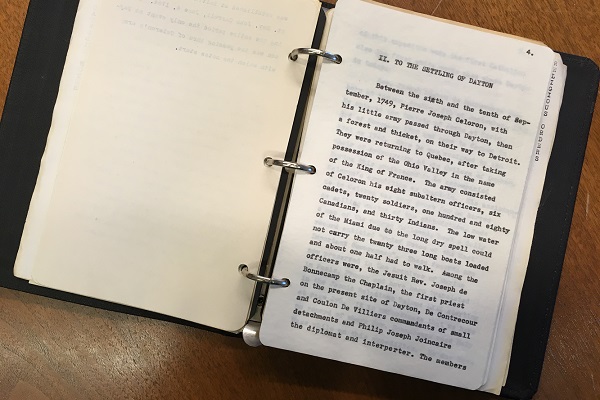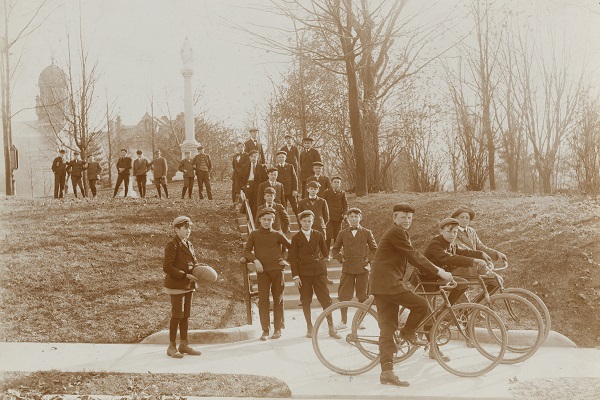University Libraries

1950s Manuscript Provides a Glimpse into Dayton Catholic History
By Amy Rohmiller
The Department of Religious Studies’ doctoral program in theology celebrates its 20th anniversary this year. When it was founded, it was the first doctoral program in the country to focus on the experience of U.S. Catholics.
In the University Archives and Special Collections, documents and artifacts from Southwest Ohio provide rich representations of the Catholic experience in the Midwest and in the United States. Thanks to a recent question from a researcher, I was lucky enough to spend some time in the University Archives’ collections reading about the Catholic experience in Dayton in Walter Weckesser’s 1950s manuscript “Dayton Catholic Historical Notes.”
A sampling of the U.S. Catholic experience
Weckesser mainly focuses on passing down the stories of very early Dayton. In his words, “Our purpose is to add to your interest in our holy faith and to preserve the little Catholic tradition that death had not silenced. … Had some one (sic) gathered Catholic notes a century ago, today we would have an excellent record.” Weckesser gathered his notes from talking to his older relatives, especially his parents, and from reading old newspapers, letters and other sources.
The notes gave me a new appreciation for how hard life was for early Dayton settlers. For instance, in the early 1800s, it took at least two days to get to Cincinnati from Dayton. In 1821, when the Archdiocese of Cincinnati was founded, two priests served the entire state. Dayton was a place to send missionaries — not a place missionaries were sent from.
Later sections of Weckesser’s notes give a fuller picture of Catholic life in Dayton. He includes short histories of Dayton parishes, schools, religious orders, and Catholic social groups and organizations present through the 1950s. Some of these names were familiar: the Knights of Columbus, St. Vincent de Paul societies, and the Marianists. Some were not so familiar: the Knights of St. George (and their impressive uniforms: “coats of velvet with armor breast plates, red plumed helmets, sword and belt, leggins (sic), boots and spurs”), Camp Marquette, and the Catholic Gesellen Verien.
Parish roots ...
The notes also gave me glimpses of other history. I learned about Dayton’s immigration history through the stories of the earliest parishes, Emmanuel and St. Joseph. According to the notes, Emmanuel was the first Catholic parish, and it appears that those with German roots ended up being its largest population. St. Joseph was founded in part to give Dayton’s English-speaking Catholics, mainly of Irish descent, a faith community. Sacred Heart, Dayton’s second English-speaking parish, now serves Dayton’s Vietnamese Catholic community.
news of note ...
I also read about a grisly murder from Dayton’s early years, and I even learned a little about the history of the French Revolution.
Discover more in the University Archives and Special Collections
If you want to learn more about the Catholic experience in the United States, you can check out the U.S. Catholic Special Collection. Or, if you want to learn more about the Catholic experience on campus, peruse the University Archives.
— Amy Rohmiller is an associate University archivist in the University Archives and Special Collections.

St. Mary's Institute, Early 1900s
St. Mary's Institute, Early 1900s

